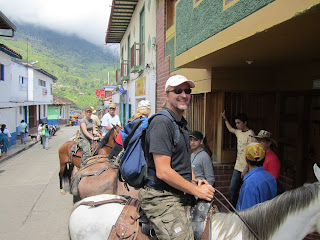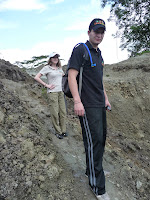Never mind that my last post was almost 2 years ago, I'm back at it! Yesterday I spent a day out of the office, and went here instead:

Very nice for a change of pace! The objective was to investigate a new tour to partially replace the coffee and horseback tour we offer in the Andean Pueblo. Don't worry, we won't discontinue the old version, but we needed a second option because the previous one had become increasingly difficult to get to, and prices were going up up up.
So, I left Medellín on Thursday evening for a (longer than expected) 5-hour bus ride to the village, and got up early Friday morning to give the new tour a go! I went with a group that's been travelling around South America since September 2010 (8 months ago!) by land with South America Overland. They contacted us on Monday saying they were on there way and would like to try the tour, so it was a perfect opportunity for me to tag along and try it out before giving it the official Diversitours stamp of approval (and be translator for a day).

The tour started around 8:30 AM on Friday morning, and we had mounted our horses to set off for the countryside by 10.
<--Here we are about ready to leave the pueblo (notice the green mountainside in the background!)
It took about an hour and a half to get to the coffee farm (finca), at a leisurely pace! In our group of 8, we had experienced riders and complete novices, and everyone arrived just fine and thrilled to take in the incredible views from the finca.

We were warmly greeted by Don Gonzalo, who we would learn was a philosopher, lawyer, and congressman before he decided to return to his routes in the countryside and learn about coffee farming - 10 years ago! We enjoyed a fresh glass of juice made from the green spiky fruit called guanabana, took in some fresh air, enjoyed our first cup off coffee of the day, and then headed off into the fields - scratch that - into the steep mountain trails, to see where and how this delicious coffee is grown!
Gonzalo grows his Rainforest Alliance Certified coffee in the shade, for a smoother, fuller cup of coffee. He has about 50,000 coffee trees (yes, it's considered a tree, he says), a small amount compared to large producers who have millions. We walked for about an hour and a half along a windy mountain train surrounded by coffee trees. I asked how the workers manage to not go tumbling down the hills; he laughed.



Because Gonzalo has a relatively small production of coffee, he's able to use artisanal growing and processing methods - he uses natural pesticides (eg. kill a naturally occurring fungus, roya, with another naturally occurring fungus that eats the bad one) and has built an "ecological barrier" of heliconia flowers to stop the (very few and internationally approved) chemicals he does use from running down the mountain into the river.
Walking along the trails we also saw that he his harvesting cardamom, which was brought to Colombia just 20 years ago and has become a profitable export crop that isn't grown anywhere else in Colombia outside of Antioquia. Colombians don't traditionally eat cardamom, in fact most of them don't like it, so it's exported to middle eastern countries.
Now, back to coffee. Once the green "beans" turn read or yellow on the tree, they are ready to pick. Picking unripe beans dramatically lowers the quality of the coffee. Once the beans are picked, they are sent through a simple machine that peels the skins off and rinses the gooey juice off of the seed, using as little water as possible. Then the beans (which are actually seeds, mind you, I really have no idea why we call them beans in English) are left to ferment for 12 hours, and a simple filter system is used to qualify them, by running them down a stream and separating the heaviest ones that sink (these are the best) from the the lightest ones that float. Gonzalo sorts the coffee into 3 qualities: Best, normal, and worst. Surprise surprise, the "worst" is what stays in Colombia, and the best is what is mostly exported.



Then the beans dry in the sun, and another paper-like layer has to be removed. That paper-like layer serves many purposes - Gonzalo uses it on the ground in the pen for the chickens and hens, and later uses it (mixed with chicken poop!) for fertilizer. Then the beans are sorted by size (the blue machine above) and sent elsewhere to be roasted - for now at least! He's doing his research and will soon be roasting his own coffee on site, unlike most Colombian coffee growers.

After learning all this we were hungry and ready for lunch, and enjoyed a traditional lunch on a coffee farm: sancocho!
At about 3:00 PM, we were ready to hop back on our horses and head back to the village. By this time we'd had at least 4 cups of coffee, plus a small back to take home and make our own!
The ride back took just under an hour. We were very lucky to have sunshine all day long, and over all had a great day!

If you want to check it out for yourself, contact us and we'd be happy to arrange private or
public transport to the village, plus your accommodation and guide! This tour has been













